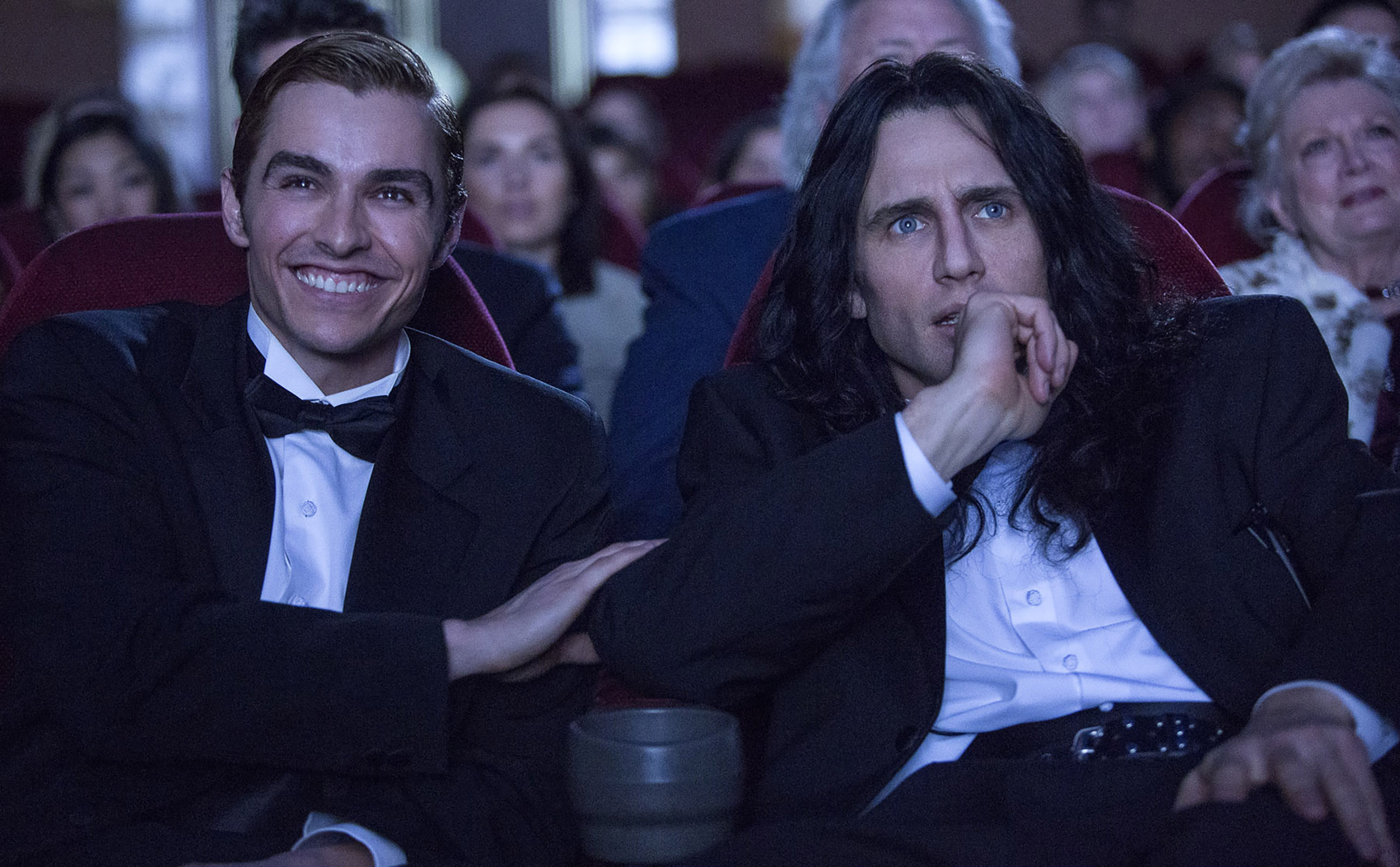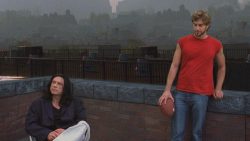Michael H. Weber and Paul Scheer Discuss The Disaster Artist

Weber and Scheer Explain their Fascination with The Room and About How their Relationship with it has Changed Since Making The Disaster Artist
The Room—one of the most notorious cult films of all time—is a movie seared into filmgoers’ consciousness by the utterly unique vision of its enigmatic writer, director, and star Tommy Wiseau. Its production was a disaster, famously documented in co-star Greg Sestero’s tell-all book The Disaster Artist: My Life Inside The Room, the Greatest Bad Movie Ever Made.
Sestero’s book became the source material for The Disaster Artist, a movie about the making of The Room, appropriately directed and starring James Franco, one of Hollywood’s most enigmatic actors. Played as an outrageous comedy, the film, which is adapted from Sestero’s book by screenwriters Michael H. Weber and Scott Neustadter, co-stars Franco’s brother Dave as Greg Sestero and features an incredible lineup of comedians, including Seth Rogen, Paul Scheer, June Diane Raphael, Jason Mantzoukas, Hannibal Burress, Jarrod Carmichael, and Megan Mullally.
The Independent’s Evan Crean spoke with Michael H. Weber and actor/comedian Paul Scheer, about how they got involved with The Disaster Artist, how their relationship with The Room has evolved, and how it was able to so successfully channel Tommy Wiseau.
Evan Crean: Michael, how did you get attached to this project?
Michael H. Weber: My writing partner, Scott Neustadter and I have written some relationship stories before. We were sent the book from James Franco and Seth Rogen having never met any of those guys. We read the book and loved it. Neither of us had seen The Room yet. Scott stopped about three chapters in to watch The Room by himself, which is obviously not the way-
Paul Scheer: The worst way to do it.
Weber: You need someone to guide you. I waited until after we wrote the first draft to watch The Room, because we wanted a movie that played not just for superfans of The Room, which is such a small passionate subset of movie culture. The Disaster Artist had to work for people who had never even heard of The Room. The book is amazing and so comprehensive.

Scott and I took it apart, and sort of put the production chapters over here, and really focused on the chapters that were about the friendship. Because for us, at the end of the day, the making of the movie is the backdrop in some ways and is what tests the friendship. But ultimately, this was a story about a friendship and a somewhat dysfunctional bond, and one that is tested by the making of this piece of art of questionable quality.
EC: Has your experience with The Room changed after making The Disaster Artist?
Scheer: I just did a podcast with Amy Nicholson, who is the L.A. Times and MTV movie critic. “The Canon.” We sat there, and we analyzed The Room as if it was Citizen Kane. And it was really interesting to pull it apart, ’cause after seeing it so many times … I don’t know if I think it’s a bad movie anymore. I think that it’s this artifact of this very specific thing that cannot be … its uniqueness needs to be embraced. It redefines the grammar of film. I’m not saying it worked, but it needs to be looked at in that way. I understand a little bit more, seeing the script of it, and now talking about it. You realize that this is a movie that, as we talked about in the podcast, belongs in the canon of film. If you’re teaching a film class, I think it should go in there, because no one has ever done it.
There’s a lot of mediocre bad movies, and there’s a lot of movies that were made for shock or camp … this is a pure artistic vision, and there are choices in there, and there are things in there, and I think you could learn as much from this as you could learn from a great film. That’s what I would say.
Weber: My relationship with The Room has evolved only to the extent that I know how hard it is to get anything made. There’s so much compromise along the way, and here’s Tommy who made something without compromising at all. It’s so purely his vision that that’s the thing you don’t get to see, of a purely pure vision. Every choice is really Tommy’s vision and Tommy’s choice. That is what is so unique.
Scheer: I will also say, I do this podcast, “How Did This Get Made,” where we talk about bad movies, and there’s something really interesting, in my opinion, when you find the movies that are people’s passion projects. The director who had been working had been successful and then made this. It’s the movie that they couldn’t get made first. And those are always, to me, the most interesting, because there’s a reason why somebody said no to it. But there’s this story that needed to be told. And I feel like those are the most interesting because they’re the most unique.
EC: I’m a huge fan of “How Did This Get Made.”
Scheer: Oh thanks.
EC: So I have to ask, what was it like being in a movie about the making of a movie that you’ve covered on the show, and all three of you from the podcast are in?
Scheer: Yeah. It was surreal. I mean, the most surreal thing was finding out that James [Franco] didn’t even know we did a podcast about The Room or we did this podcast when he cast us. It was really fun. I’ll go back and say that Seth and Evan who produced the movie, have always treated me really well and put me in stuff and has been good support. It was as if working on any other movies, but it was getting to be a kid in a candy store, because this is a movie that I really do connect with and then you’re like I’m in this thing?
But I would say, where it got really surreal was being in a movie with Tommy and Greg, and I am in what they are considering the third part of the trilogy, the trilogy being The Room, The Disaster Artist, and their new film, which is a two-parter by the way. So I did a scene with Tommy and Greg in a morgue, and acting against Tommy was everything that I had hoped for.
EC: Michael, did you and Scott grow a kinship to Tommy and Greg?
Weber: We did. There was a lot of interesting relationships like that, because Tommy and Greg met almost 20 years ago in acting class. Scott and I met almost 20 years ago at a production company in New York. Scott and I both shared a dream that we wanted to write together and people had told us no, and we sort of believed in each other before anyone else believed in us. And that shared dream is something that’s at the heart of why Tommy and Greg first bonded and are still friends and collaborators all these years together, and also James and Seth who met about 20 years ago working on Freaks and Geeks and shared a dream. It’s kinda cool that at the heart of The Disaster Artist are a lot of these relationships that go back almost two decades of two people who shared a dream and kinda went after something together that seemed impossible.

EC: Tommy is such a big character. How were you able to capture his essence in the movie?
Weber: It’s a tribute to the book, first of all, because the book really is so comprehensive. It felt like we could channel Tommy. We could not ask for a better partner in terms of Greg being deferential to us to write the best movie. We invented, or thought we did, lines for Tommy. And Greg was on set, and the couple of times where we thought we made things up, Greg actually said to us no actually that’s something Tommy really said. Which was both a nice compliment but then crazy that we were so in Tommy’s head that we were channeling him in such a way.
Scheer: It’s funny, ya know you say that, ’cause my wife June is in the movie. Plays Robyn Paris in The Room film, has that monologue where she’s like ‘who do you think these people are?’ And I saw Robyn at the premiere and she said to me she’s like it’s so funny, ‘I literally had that conversation.’ She’s like, ‘That’s me.’ I think part of it is Greg’s memory created this framework that’s so solid that it’s easy to extrapolate and pull out.
Weber: The biggest challenge was cutting down because there’s so much in the book. This could’ve easily been an eight-hour mini-series kind of thing. It was sort of that we had to cut things and let things go because let’s make this a story about friendship. The making of the movie is the backdrop and the thing that tests the friendship. And we thought emotionally the stakes are so much higher if this is about the friendship rather than the question of did they make a good movie or a bad movie.
Regions: Los Angeles, United States
